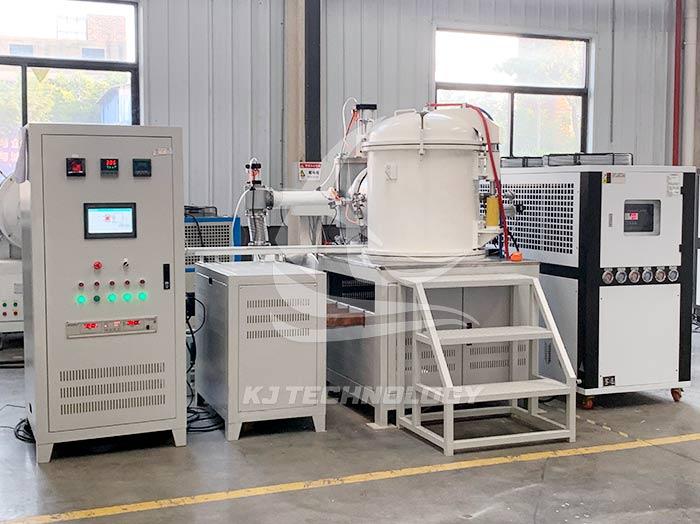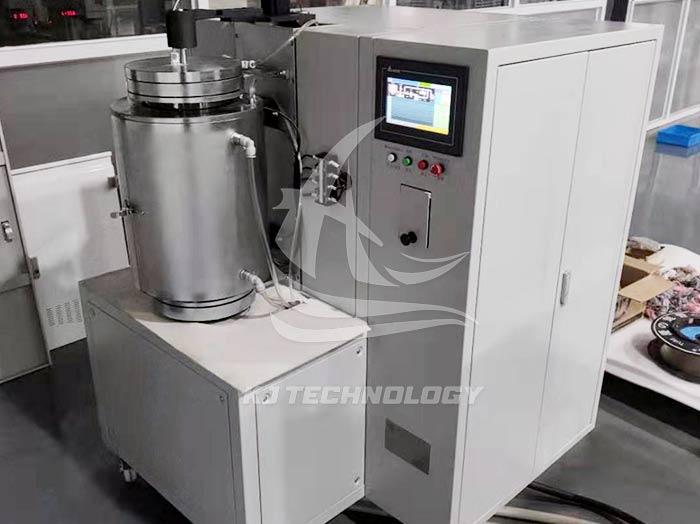Can a laboratory graphite vacuum furnace be used for sintering experiments?
 08-06-2025 Author: KJ technology
08-06-2025 Author: KJ technology
The laboratory graphite vacuum furnace is fully capable of conducting sintering experiments, and its high-temperature performance, vacuum environment, thermal conductivity, structural stability, and controllable atmosphere make it an ideal equipment for sintering experiments. The following provides a detailed analysis from four aspects: sintering principle, equipment advantages, applicable materials, and experimental operations:
1. The adaptability of sintering principle and vacuum furnace
Sintering is the process of forming dense materials by heating at high temperatures to bond particles in powders or compacts. The core conditions include:
High temperature environment: softens or melts the surface of particles, promotes atomic diffusion and particle bonding.
Low oxygen environment: prevent metal or ceramic materials from oxidizing at high temperatures and avoid oxide films hindering particle bonding.
Uniform temperature field: Ensure synchronous shrinkage of all parts of the material, reducing cracking or deformation.
The laboratory graphite vacuum furnace meets sintering requirements through the following characteristics:
High temperature performance: Graphite heating elements can withstand extremely high temperatures (usually exceeding 2000 ℃), much higher than the temperature required for most sintering processes (such as metal sintering at around 800-1200 ℃ and ceramic sintering at around 1200-1600 ℃).
Vacuum environment: The maximum vacuum degree can reach 10-6mbar, effectively eliminating oxygen and preventing material oxidation, especially suitable for sintering of active metals (such as titanium, aluminum) or high-purity ceramics.
Uniform thermal conductivity: Graphite has high thermal conductivity, and with a reasonable furnace design, it can ensure a uniform temperature field, avoiding cracking or uneven density caused by local overheating or underheating.
2. The advantages of vacuum furnace in sintering experiments
Improve material performance:
High density: The vacuum environment reduces gas pores, promotes particle bonding, and enhances material density and strength.
Low impurity content: avoids the introduction of oxidative impurities, improves material purity, and is suitable for high-purity demand fields such as semiconductors and optical ceramics.
Controllable grain growth: By precisely controlling temperature and cooling rate, abnormal grain growth is suppressed and material microstructure is optimized.
Process flexibility:
Atmosphere regulation: In addition to vacuum, inert gases (such as argon) or reactive gases (such as nitrogen) can be filled to meet different sintering process requirements. For example, nitride sintering of silicon nitride ceramics can be achieved under a nitrogen atmosphere.
Temperature curve programming: supports multi-stage heating, insulation, and cooling programs to meet the requirements of complex sintering processes such as staged sintering and debinding sintering integration.
Experimental safety and reliability:
Sealed design: prevents gas leakage and avoids failure due to oxidation or contamination during the experimental process.
Water cooling system: protects the furnace body and electrical components, extends equipment life, and ensures long-term stable operation.
Data recording: Equipped with an automated control system, real-time monitoring and recording of temperature, vacuum degree and other parameters for easy experimental reproduction and optimization.
3. Suitable for sintering materials and experimental scenarios
Metallic materials:
Hard alloy: sintering of tungsten cobalt (WC Co) alloy, vacuum environment can prevent cobalt phase oxidation, improve alloy hardness and wear resistance.
High temperature alloys, such as nickel based alloys, are sintered in a vacuum environment to reduce element volatilization and maintain alloy composition stability.
Powder metallurgy parts, such as gears and bearings, can be sintered in a vacuum furnace to improve their density and mechanical properties.
Ceramic materials:
Alumina ceramics: Vacuum sintering can eliminate pores, improve ceramic insulation and mechanical strength.
Silicon nitride ceramics: sintered under a nitrogen atmosphere to achieve nitriding reaction and prepare high-strength and high toughness ceramics.
Transparent ceramics: sintering of yttrium oxide transparent ceramics reduces light scattering centers in a vacuum environment and improves transmittance.
compound material:
Metal ceramic composite materials: sintering of iron-based composite materials reinforced with titanium carbide, vacuum environment promotes interface bonding, and enhances the performance of composite materials.
Ceramic ceramic composite materials, such as alumina zirconia composite materials, can be sintered in a vacuum furnace to optimize phase distribution and improve material toughness.
4. Sintering experiment operation process and precautions
Preparation before the experiment:
Sample preparation: Press the powder material into shape (such as cold pressing, isostatic pressing), or directly use the preform.
Furnace cleaning: Remove residues inside the furnace to avoid contaminating the sample.
Parameter setting: Set temperature curves (such as heating rate, holding time, cooling rate) and vacuum requirements based on material characteristics.
Experimental operation:
Sample installation: Place the sample in the center of the furnace, avoiding contact with heating elements or furnace walls.
Vacuum pumping: Start the vacuum pump to pump the furnace to the target vacuum level (such as 10-3mbar).
Heating and insulation: Heat up to the sintering temperature according to the set program and maintain it for sufficient time to promote particle bonding.
Cooling: Choose natural cooling or forced cooling (such as accelerated cooling with inert gas) according to process requirements.
matters needing attention:
Temperature uniformity: Avoid samples that are too large or placed improperly, which can cause excessive temperature gradients and lead to cracking or deformation.
Vacuum control: Regularly check the sealing of the vacuum system to prevent air leakage and oxidation.
Safety protection: Wear protective equipment (such as gloves and goggles) during operation to avoid high temperature burns or vacuum pump noise injuries.








